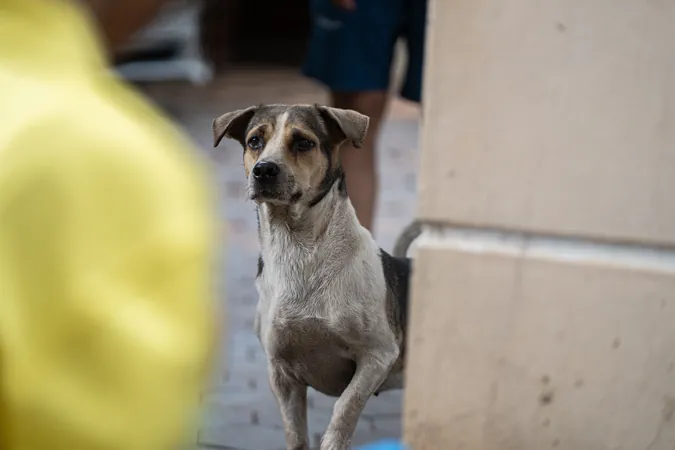
Major Breakthrough in Rabies Vaccination: Nearly 230,000 Dogs Immunized in Cambodia
2024-11-05
Author: Jia
Overview
In a groundbreaking two-week campaign to combat rabies in Cambodia, a staggering 229,488 dogs were vaccinated against the disease, marking this effort as the largest rabies vaccination initiative ever conducted in Asia. This impressive feat was orchestrated by the Worldwide Veterinary Service (WVS), a UK-based charity dedicated to providing veterinary care and essential supplies to animals in need around the globe.
Collaboration and Leadership
Collaborating partners included Animal Rescue Cambodia and the General Directorate of Animal Health and Production, working in tandem to drive this mission forward. Luke Gamble, the CEO and founder of WVS, expressed immense pride in the campaign's success. “Vaccinating 229,488 dogs in Cambodia in just 2 weeks is a new milestone we’re immensely proud of. It proves that with the right strategy, energy, and support, eliminating rabies is within reach,” he stated.
Campaign Details
The campaign ran from October 21 to November 4, 2024, aligning seamlessly with Cambodia's National Strategic Plan for Rabies Control and Elimination. This initiative supports the broader Global Strategic Plan aimed at eradicating deaths caused by dog-mediated rabies by 2030. Approximately 300 vaccination teams were dispatched to various provinces, including Phnom Penh, Kandal, and Battambang, to ensure a widespread immunization effort. These teams canvassed neighborhoods, bringing vaccinations directly to the dogs' doorsteps.
Technology Utilized
To facilitate this immense task, WVS utilized a specialized “rabies app” which aided teams in mapping out their vaccination zones and recording data on each vaccinated dog. Such technological tools were crucial for tracking the project’s progress and efficacy.
Mission Rabies Project
This initiative is part of WVS's "Mission Rabies" project, which has been operational in Cambodia since 2019. The primary objectives include not only vaccinating dogs but also educating the community about rabies and its prevention. In 2023, an initial vaccination effort saw 74,983 dogs immunized — a significant step in a country where rabies remains a severe public health threat.
Response and Education
In response to rabies alerts and potential bites, a 24-hour surveillance team has been established to ensure rapid response services and post-exposure treatments are accessible. With a goal to vaccinate at least 70% of the local dog population, this initiative aims to eradicate rabies in canines, thereby significantly reducing the risk of human infection.
Statistics and Impact
Statistics from the World Health Organization indicate that dogs are responsible for nearly 99% of human rabies cases. Alarmingly, children aged between 5 and 14 years bear a disproportionate burden, accounting for 40% of rabies-related deaths worldwide. In Phnom Penh alone, one child succumbs to rabies every week, highlighting the dire need for preventive measures in this vulnerable demographic.
Community Outreach
Education is a core component of Mission Rabies, with initiatives designed to raise awareness about the importance of vaccinations, the risks associated with rabies, and effective prevention strategies. This outreach extends to schools, workplaces, and community centers throughout Cambodia.
Additional Services
In addition to vaccination efforts, the campaign also included a free spaying and neutering service at the Royal University of Agriculture, successfully sterilizing 212 animals. Moreover, a mobile veterinary team was deployed to treat 538 sick and injured animals, showcasing the comprehensive nature of this important initiative.
Volunteers and Future Impact
With over 200 veterinary students from Cambodia and volunteers from 30 countries assisting in the campaign, the collective effort embodies a remarkable spirit of community and collaboration. According to Gamble, this campaign is projected to prevent around 500 children from dying of rabies in the coming years—a testament to the life-saving impact of veterinary outreach and public health initiatives.



 Brasil (PT)
Brasil (PT)
 Canada (EN)
Canada (EN)
 Chile (ES)
Chile (ES)
 España (ES)
España (ES)
 France (FR)
France (FR)
 Hong Kong (EN)
Hong Kong (EN)
 Italia (IT)
Italia (IT)
 日本 (JA)
日本 (JA)
 Magyarország (HU)
Magyarország (HU)
 Norge (NO)
Norge (NO)
 Polska (PL)
Polska (PL)
 Schweiz (DE)
Schweiz (DE)
 Singapore (EN)
Singapore (EN)
 Sverige (SV)
Sverige (SV)
 Suomi (FI)
Suomi (FI)
 Türkiye (TR)
Türkiye (TR)